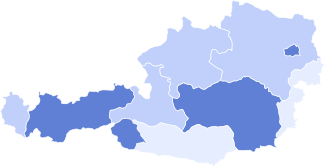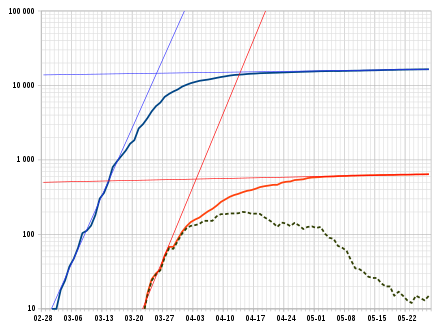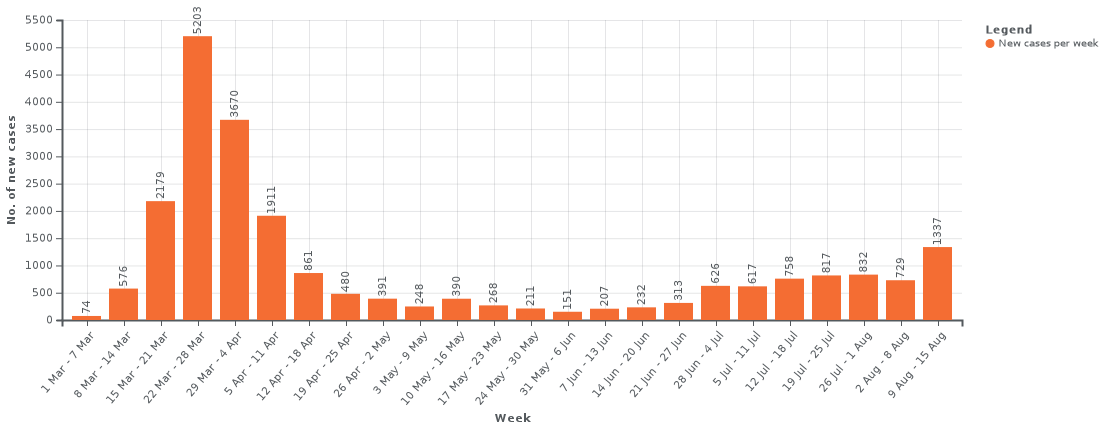COVID-19 pandemic in Austria
The COVID-19 pandemic in Austria is part of the ongoing worldwide pandemic of coronavirus disease 2019 (COVID-19) caused by severe acute respiratory syndrome coronavirus 2 (SARS-CoV-2). In Austria, a pair of cases were confirmed on 25 February 2020. The cases involved a 24-year-old man and a 24-year-old woman who were travelling from Lombardy, Italy, and were treated at a hospital in Innsbruck.[2][3][4][5] According to new figures released by Austrian authorities on 23 June, the first case in the country was recorded in Ischgl, Tyrol on 8 February.[6]
| COVID-19 pandemic in Austria | |
|---|---|
 .svg.png)  | |
| Disease | COVID-19 |
| Virus strain | SARS-CoV-2 |
| Location | Austria |
| First outbreak | Wuhan, Hubei, China |
| Index case | Ischgl |
| Arrival date | 8 February 2020 |
| Confirmed cases | 23,370[1] |
| Active cases | 1,961[1] |
| Recovered | 20,681[1] |
Deaths | 728[1] |
| Fatality rate | 3.12% |
| Government website | |
| Ministry of the Interior | |
Background
On 12 January 2020, the World Health Organization (WHO) confirmed that a novel coronavirus was the cause of a respiratory illness in a cluster of people in Wuhan, Hubei, China, which was reported to the WHO on 31 December 2019.[7][8]
The case fatality ratio for COVID-19 has been much lower than SARS of 2003,[9][10] but the transmission has been significantly greater, with a significant total death toll.[11][9]
Events
On 25 February, Austria confirmed the first two cases of COVID-19, a 24-year-old man and a 24-year-old woman from Lombardy, Italy tested positive and were treated at a hospital in Innsbruck, Tyrol.[12][13][14][15]
On 27 February, a 72-year-old man in Vienna had been in the Krankenanstalt Rudolfstiftung hospital for 10 days with flu symptoms before he tested positive for SARS-CoV-2. He was then transferred to Kaiser-Franz-Josef Hospital.[16][17][18][19] A couple who tested positive and their two children who were showing symptoms were admitted to Kaiser-Franz-Josef Hospital. The family had previously been on holiday in Lombardy, Italy.[16][17] On 28 February, one of the children, a 15-year-old boy tested positive. Due to the illness, precautions were taken at his high school as 4 teachers and 23 students born between 2003 and 2005 were sent home for isolation.[20]
Beginning from 1 March, authorities in Germany and the Nordic countries began identifying the Tyrolean ski resort town of Ischgl as a major coronavirus hotspot. Several hundred infections were eventually traced back to the town with transmissions having occurred from late February onwards. After initially playing down the risks, authorities in Tyrol placed the entire town in quarantine on 13 March.[21]
On 10 March, the government announced that all universities would close their classes at the latest by 16 March. All outdoor events with more than 500 people and all indoor events with more than 100 people were cancelled. All children older than 14 years old were ordered to stay at home, starting 15 March, with the younger children starting 17 March. This applied until 4 April.[22] Travel restrictions for people coming from Italy are established. The government asked the general public to avoid social contact and announced even further restrictions to be made soon.[23]
On 12 March, Austria confirmed the first death of COVID-19, a 69-year-old man from Vienna died in Vienna's Kaiser-Franz-Josef Hospital.[24]
By 13 March, there were 422 confirmed cases.[25]
Potential COVID-19 infected persons should under no circumstances go to a doctor or to an outpatient clinic to reduce the risk of infection. They were asked to call the Healthcare number 1450 instead. On 15 March, there were about 70 times as many calls as on other Sundays before the pandemic.[26]
On 15 March, a ban was also announced for public gatherings of more than five people, and restaurants were ordered to close beginning on 17 March.[27] In addition, Günther Platter, the governor of Tyrol, announced a one-week lockdown for the whole province.[28][29] Residents in Tyrol were required to remain in their homes except for necessary reasons such as purchasing food or medicine, visiting the doctor, withdrawing cash, or walking a dog.[28]
As of 16 March, nationwide, homes may only be left for one of the following reasons:[30]
- necessary professional activities
- necessary purchases (groceries or medication)
- assisting other people
- activities outside, alone or in the company of people living in the same household
On 27 March, Federal Minister of Health Rudolf Anschober announced that in Austria the pandemic was expected to peak between mid-April and mid-May 2020.[31]
On 30 March, the Austrian government announced that everyone entering a store has to wear a face mask, effective 6 April.[32]
On 30 March, the Austrian government announced that they would be conducting random tests.[33]
From 1 April to 6 April, the random tests were conducted by the SORA Institute who contacted 2000 randomly selected candidates in regions affected by the virus; 1544 of the candidates were tested. Based on the study, the prevalence of the infection in the non-hospitalized population was recalculated, resulting in an estimate around 0.33%.[34][35][36] The results were announced on 10 April.[37]
On 14 April, wearing face masks became mandatory on public transportation as well. At the same time, stores such as retail shops and home improvement stores that are under 400 square metres may already reopen.[38]
On 17 May, Austria reported no additional COVID-19 death in the past 24 hours for the first time since 20 March.
Timeline
Cases, deaths and recoveries
 Number of cases (blue) and number of deaths (red) on a logarithmic scale. |
New cases per week
 | |
Prevention measures
On 16 March, a nationwide curfew went into force. Homes may only be left for a handful of specified reasons, see above.[30] Non essential work that cannot be done from home was stopped.
On 17 March, in addition to border checks, Austria banned all arrivals from Italy, China's Hubei Province, Iran, and South Korea, excepting those who had a medical certificate no more than four days old that confirmed they were not affected by coronavirus.[39]
On 27 March, it was announced that no further prevention measures are planned.[31]
On 30 March, the government laid out plans to introduce compulsory wearing of face masks covering mouth and nose. From 6 April onwards, this will only affect persons entering supermarkets, but will be extended to more public places in the near future.[40]
On 21 May, the Austrian Chancellor Sebastian Kurz stated that tourism is a driving force of the Austrian economy, accounting for about 8% of its GDP and involving hundreds of thousands of employees.[41] He invited German tourists usually directed to Italy to vacation in safer Austria and contextually launched a 40 million Euro international campaign for tourism.[42]
On 23 May, tourists coming from Germany and Switzerland to Italy were allowed to cross Austrian borders, but with the prohibition of any kind of stop within their national area.[43]
On 3 June, the Austrian Foreign Minister Alexander Schallenberg told Austria had agreed with Germany, Switzerland, Liechtenstein, Slovenia, Hungary, Slovakia and the Czech Republic that their countries' borders will be reciprocally reopened from 4 June.[44] The agreement doesn't yet affect the borders with Italy.[45]
References
- "Bundesministerium für Inneres: Aktuelle Zahlen zum Corona-Virus" (in German). Innenministerium. Retrieved 30 May 2020.
- "Austria reports first two cases of coronavirus". The Guardian. Associated Press. 25 February 2020. Archived from the original on 25 February 2020. Retrieved 25 February 2020.
- "Coronavirus: Zwei Fälle in Tirol bestätigt". news.ORF.at (in German). 25 February 2020. Retrieved 25 February 2020.
- Busby (now), Mattha; Belam, Martin; Marsh, Sarah; Rourke, Alison; Farrer (earlier), Martin; Busby, Mattha; Adams, Richard; Parveen, Nazia; Wearden, Graeme (25 February 2020). "Coronavirus news: Austria and Croatia report first cases as Tenerife quarantines hotel – live updates". The Guardian. ISSN 0261-3077. Retrieved 25 February 2020.
- Helen Regan; Adam Renton; Meg Wagner; Mike Hayes; Veronica Rocha (25 February 2020). "Austria's 2 coronavirus cases are Italian citizens". CNN. Retrieved 25 February 2020.
- "Eintragungsfehler: "Patient 0" in Ischgl nun doch schon im Februar". Tiroler Tageszeitung. 23 June 2020. Retrieved 23 June 2020.
- Elsevier. "Novel Coronavirus Information Center". Elsevier Connect. Archived from the original on 30 January 2020. Retrieved 15 March 2020.
- Reynolds, Matt (4 March 2020). "What is coronavirus and how close is it to becoming a pandemic?". Wired UK. ISSN 1357-0978. Archived from the original on 5 March 2020. Retrieved 5 March 2020.
- "Crunching the numbers for coronavirus". Imperial News. Archived from the original on 19 March 2020. Retrieved 15 March 2020.
- "High consequence infectious diseases (HCID); Guidance and information about high consequence infectious diseases and their management in England". GOV.UK. Archived from the original on 3 March 2020. Retrieved 17 March 2020.
- "World Federation Of Societies of Anaesthesiologists – Coronavirus". www.wfsahq.org. Archived from the original on 12 March 2020. Retrieved 15 March 2020.
- "Austria reports first two cases of coronavirus". The Guardian. Associated Press. 25 February 2020. Archived from the original on 25 February 2020. Retrieved 25 February 2020.
- red, ORF at/Agenturen (25 February 2020). "Coronavirus: Zwei Fälle in Tirol bestätigt". news.ORF.at (in German). Retrieved 25 February 2020.
- Busby (now), Mattha; Belam, Martin; Marsh, Sarah; Rourke, Alison; Farrer (earlier), Martin; Busby, Mattha; Adams, Richard; Parveen, Nazia; Wearden, Graeme (25 February 2020). "Coronavirus news: Austria and Croatia report first cases as Tenerife quarantines hotel – live updates". The Guardian. ISSN 0261-3077. Retrieved 25 February 2020.
- Helen Regan; Adam Renton; Meg Wagner; Mike Hayes; Veronica Rocha (25 February 2020). "Austria's 2 coronavirus cases are Italian citizens". CNN. Retrieved 25 February 2020.
- "Dritter bestätigter Coronavirus-Fall in Wien – derStandard.at". DER STANDARD (in German). Retrieved 27 February 2020.
- red, wien ORF at/Agenturen (27 February 2020). "Coronavirus: Drei bestätigte Fälle in Wien". wien.ORF.at (in German). Retrieved 27 February 2020.
- birgit.seiser,katharina.zach. "Coronavirus erreicht Wien: 72-Jähriger erkrankt". kurier.at (in German). Retrieved 27 February 2020.
- red, ORF at/Agenturen (27 February 2020). "Coronavirus: Wiener Patient seit zehn Tagen im Spital". news.ORF.at (in German). Retrieved 27 February 2020.
- red, ORF at/Agenturen (28 February 2020). "Infektion in Steiermark: Bereits sieben bestätigte CoV-Fälle". news.ORF.at (in German). Retrieved 28 February 2020.
- Karnitschnig, Matthew (19 March 2020). "The Austrian ski town that spread coronavirus across the Continent". Politico. Retrieved 21 March 2020.
- "Coronavirus: Stufenweise ab Montag: Österreich schließt Schulen «". Kleinezeitung.at. 11 March 2020. Retrieved 15 March 2020.
- bock, sita, beide ORF.at/Agenturen (10 March 2020). "Coronavirus: Starke Einschränkungen beschlossen – news.ORF.at". Orf.at. Retrieved 15 March 2020.CS1 maint: multiple names: authors list (link)
- "Austria Reports First Death from COVID-19 – Vindobona.org | Vienna International News". Vindobona.org. Retrieved 15 March 2020.
- "Sozialministerium: Aktuelle Informationen: Neuartiges Coronavirus" (in German). Retrieved 6 March 2020.
- "Coronavirus: Kaum Wartezeit bei Gesundheitshotline 1450 in NÖ". kurier.at (in German). Retrieved 27 March 2020.
- "Austria Coronavirus News: Österreich Aktuelle Virus Nachrichten". Bloomberg. 15 March 2020. Retrieved 1 April 2020.
- "The Latest: US CDC recommends strict 8-week limit on crowds". AP NEWS. 15 March 2020.
- "Austria's Tyrol province orders lockdown". Boston Globe.
- ORF.at/Agenturen (16 March 2020). "Ausgangsbeschränkungen – Was nun erlaubt ist und was nicht – news.ORF.at". Orf.at. Retrieved 16 March 2020.
- "Spitze zwischen 'Mitte April und Mitte Mai'". orf.at. 27 March 2020. Retrieved 27 March 2020.
- "Regierung verschärft Maßnahmen". ORF. 30 March 2020. Retrieved 30 March 2020.
- "COVID-19 Study". APA. 30 March 2020. Retrieved 30 March 2020.
- "SORA Studie COVID-19 Prevalence" (PDF). SORA.at. 1 April 2020. Archived from the original (PDF) on 29 April 2020. Retrieved 1 April 2020.
- "Statistik Austria Bericht". Statistik.at. 6 April 2020. Retrieved 6 April 2020.
- "BMBWF Forschungsgruppe". bmbwf. 10 April 2020. Archived from the original on 14 April 2020. Retrieved 10 April 2020.
- "SORA COVID-19 Study". SORA.at. 10 April 2020. Retrieved 10 April 2020.
- red, ORF at/Agenturen (10 April 2020). "Neue Verordnungen: Details zu Handelsöffnung und Maskenpflicht". news.ORF.at (in German). Retrieved 12 April 2020.
- "Coronavirus: Which countries have travel bans?". CNN. 17 March 2020. Retrieved 17 March 2020.
- "Regierung verschärft Maßnahmen". orf.at. 30 March 2020. Retrieved 30 March 2020.
- Bresolin, Marco (21 May 2020). "Austria, Kurz: "Non apriremo le nostre frontiere a Paesi che non hanno la situazione sotto controllo"". La Stampa (in Italian). Archived from the original on 6 June 2020.
- "L'Austria alza un muro con l'Italia: "Non apriremo confini a chi non ha il controllo della situazione"" (in Italian). 21 May 2020. Archived from the original on 6 June 2020. Retrieved 6 June 2020.
- "I turisti tedeschi potranno venire in Fvg: l'Austria aprirà un corridoio". Il Piccolo (in Italian). Trieste. 23 May 2020. Archived from the original on 6 June 2020. Retrieved 6 June 2020.
- "Austria lifting coronavirus border checks with all neighbours bar Italy". Euractiv.com. 4 June 2020. Archived from the original on 6 June 2020. Retrieved 6 June 2020.
- "Austria to scrap controls at all land borders except Italy". 3 June 2020. Archived from the original on 6 June 2020. Retrieved 6 June 2020.
External links
| Wikimedia Commons has media related to COVID-19 pandemic in Austria. |
- Data and maps, frequently updated:
- "Coronavirus Austria updates and news" [Latest news and statistics of coronavirus in Austria.] (in English, French, Spanish, Portuguese, German, Italian, Swedish, Norwegian, Finnish, Estonian, and Russian). Retrieved 4 April 2020.
- Coronavirus COVID-19 Global Cases and historical data by Johns Hopkins University
- Interactive map for Austria by Sozialministerium
- Coronavirus: Erster Todesfall in Österreich